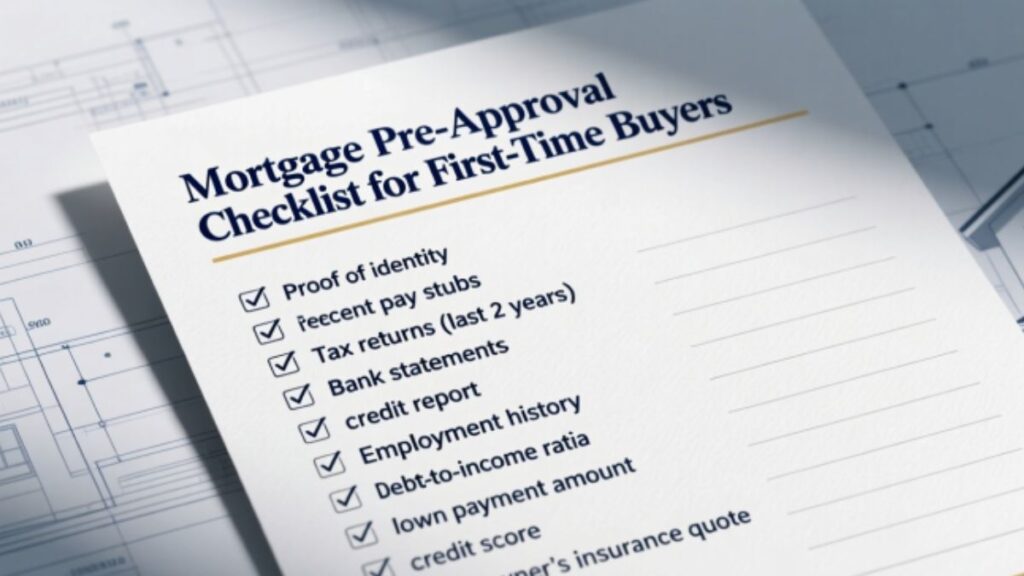A mortgage pre approval tells you, in principle, how much a lender would be willing to lend. It is not the final mortgage, but it gives you a realistic budget, makes your offer stronger and speeds up the process once you find a home. For first time buyers, having a simple mortgage pre-approval checklist for first-time buyers keeps things calm and organised from the start.
This short intro will save you time. Bring the basics to your lender and you can get a decision much faster. The checklist below covers the essentials lenders usually ask for so you are ready to apply and to move quickly when the right property appears.
Mortgage Pre-Approval Checklist for First-Time Buyers
A pre-approval checklist helps first-time buyers stay focused, organised and ready to move when the right home appears.
☐ Photo ID and proof of address (Passport or driving licence plus a recent utility bill)
☐ Last three payslips or tax returns if self-employed (Shows steady income)
☐ Three months of bank statements (Shows savings and the deposit)
☐ Simple list of debts and monthly payments (Include credit cards, loans and any child support)
☐ Proof of deposit source (Savings history, sale completion papers, or a signed gift letter)
Tip: check your credit score early and avoid taking on new credit while your pre-approval is active.
What is Mortgage Pre Approval
A mortgage pre-approval is a quick check from a lender or broker that tells you, in principle, how much they might lend. It is not the final mortgage, but it gives you a realistic budget and makes your offer stronger when you start house hunting.
What lenders usually check
Proof of income, for example payslips or tax returns.
Recent bank statements showing savings and your deposit.
ID and proof of address.
Any existing debts and monthly payments.
Your credit report and score.
Key Point: the pre approval figure is conditional. The lender will confirm it only after full document checks, a property valuation and final underwriting.
Quick Tip: Use a simple mortgage pre-approval checklist for first-time buyers to get organised. If you like, I can turn this into a one page printable checklist you can take to a meeting with a lender.
Why Should First Time Buyers Get Pre Approved?
Getting pre approved makes the whole process easier and less stressful.
You know your real price range before you start looking, so you do not waste time.
Sellers and agents take your offer more seriously when you have pre approval.
You can act quickly when you find the right home because some checks are already done.
Pre approval spots problems early, such as missing documents or affordability issues, so you can fix them before you make an offer.
It helps you compare mortgage products with clear expectations so you choose the right deal.
Quick Tip: a short pre approval saves time and keeps you confident during house hunting.
When to apply for pre approval?
You should apply for pre approval once you know how much you can put down as a deposit and what monthly payments fit your budget. For first time buyers, this usually means after you have saved your deposit and chosen a target area.
Start the process before you begin looking at properties. A typical pre approval lasts 60 to 90 days, so plan it to cover the period when you will be actively house hunting. This way, you are ready to make an offer quickly when you find the right home.
Quick Tip: timing your pre approval correctly can save you stress and help you act fast in a competitive market.
Documents You Will Normally Need
When applying for a mortgage pre-approval, having the right documents ready makes the process much smoother. Here’s what lenders usually ask for:
Identity and residency
Valid passport, driving licence, or other government ID.
Proof of current address, like a recent utility bill or council tax bill.
Proof of income for employed applicants
Most recent three months’ payslips.
Latest P60 or year-end summary.
Employer reference if requested.
Recent bank statements showing salary payments.
Proof of income for self employed applicants
Last two years’ tax returns and SA302s or accounts.
Certified accounts from an accountant if applicable.
Evidence of ongoing contracts or client invoices.
Business bank statements.
Proof of deposit and source of funds
Bank statements showing savings and deposit amounts.
Documents to show the source if the deposit comes from a gift, loan, or sale of an asset. Lenders want to ensure funds are not an undisclosed loan.
If gifted, a signed gift letter confirming the money does not need to be repaid.
Credit and liabilities
Details of any credit cards, personal loans, student loans, car finance, or any county court judgments or defaults.
Check your credit report in advance to know what lenders will see.
Outgoings and affordability
Recent household bills and other regular spending.
Childcare, maintenance, or support payments.
Property details (if you have one in mind)
Address and selling price so the lender can do a targeted affordability check.
Other documents
Proof of any deposit protection or reservation fees already paid.
Details of your solicitor or conveyancer if you have one.
Quick Tip: keeping these documents ready in advance saves time and helps your mortgage pre-approval go smoothly.
How Lenders Assess Affordability
Lenders run an affordability test to make sure you can afford repayments now and if rates rise. The main items they look at are:
Gross income and any additional income you can reliably rely on.
Existing monthly debt commitments.
Stress test or assessment rate. Lenders often calculate affordability using a rate higher than the product rate to allow for future rises.
Loan to value ratio. A bigger deposit improves your chances and widens product choice.
Household expenses and any non standard liabilities.
Practical Tip: do your own affordability calculation in advance using a simple calculator so you know your likely borrowing range.
Deposit, Loan to Value And Mortgage Insurance
Your deposit sets the stage, your loan-to-value shows the risk, and mortgage insurance can be the hidden extra if the deposit is small.
Deposit → LTV: Your deposit size sets the Loan-to-Value. A 10% deposit = 90% LTV.
Why LTV matters: Lower LTV normally unlocks better interest rates and more lender choices.
Mortgage insurance: If your deposit is below a lender’s threshold you may need mortgage default insurance (also known as PMI or indemnity). Remember to factor this extra cost into your budget.
Practical Tip: when you test affordability, add any mortgage-insurance premium into the monthly cost so you get the true figure.
Special Cases First Time Buyers Often Face
First-time buyers often face special cases like gifted deposits, variable income, or credit history gaps that need extra checks.
Joint applicants and partners
Both applicants’ incomes and credit histories will be assessed.
If one partner has poor credit it can affect the joint application. Consider a single applicant application if that is more favourable.
Self employed applicants
Prepare SA302s, accounts and an accountant reference early. Lenders want to see stable, verifiable earnings.
Some lenders require two full years of accounts or tax returns.
Casual or zero hour contracts
Lenders look for stability. Multiple years of consistent contracting or clear ongoing contracts improve chances. Provide client lists and invoices where possible.
Recent job change
You may still qualify if the new role is similar and contract confirmed. Provide the offer letter and terms.
Credit issues
Be transparent about CCJs or missed payments and bring documents showing settled debts. Some lenders will consider your application with evidence of rehabilitation and explanation.
Must Check: How Long Does Mortgage Approval Take After Pre Approval
How long pre approval takes and what to expect?
Pre-approval can be quick in simple cases, but knowing what to expect helps you plan your timeline and avoid surprises.
Quick summary
Simple cases: ~24–48 hours.
Complex cases (self-employed, foreign income, messy credit): several days to a few weeks.
Typical validity: 60–90 days (ask your lender for their exact period).
What it means
A lender issues a conditional approval after checking credit, income and assets — it’s not final until full underwriting, property appraisal and document verification are finished.
What you’ll actually do (3 steps)
Fill application + upload core documents.
Lender runs credit and does an underwriter review (may request extra items).
You use the pre-approval to shop; final approval follows once a property is under contract and all conditions are met.
Minimal document checklist (what absolutely speeds it up)
Photo ID
Recent pay stubs (or 2 years’ tax returns if self-employed)
Last 2 bank statements
Proof of assets (investment accounts, gift letter if applicable)
List of current debts
Quick tips to avoid delays
Don’t open new credit or make large unexplained deposits.
Provide requested docs promptly and organized.
Tell the lender about any job or income changes right away.
Ways to Improve Your Chances of a Strong Pre Approval
Strong pre-approval starts with solid finances, clean paperwork, and smart preparation before you apply.
Increase your deposit / lower LTV: A bigger down payment reduces lender risk and often gets better rates or easier approvals.
Pay down existing debts: Lowering your debt balances improves affordability ratios (DTI) and shows stronger repayment capacity.
Check & fix your credit report: Pull reports, correct errors, and keep card balances low before applying.
Organize your paperwork: Neatly prepared ID, pay stubs, bank statements and tax returns speeds verification.
Use a mortgage broker: Brokers can match you to lenders or specialist products that fit non-standard situations.
Stabilize employment if possible: Longer tenure or a steady income history reduces underwriting questions.
Avoid new credit or big deposits: New accounts or unexplained large deposits can trigger extra checks or harm your score.
Common Mistakes First Time Buyers Make
First-time buyers often stumble on hidden costs, missing paperwork, or treating pre-approval as a final yes.
Ignoring total upfront & ongoing costs (legal fees, valuation, stamp duty, insurance).
Fix: Ask for a written estimate of all fees up front and add a 5–10% buffer to your budget.
Failing to document the source of the deposit
Fix: Keep clear records (bank statements, gift letters, sale proceeds) and be ready to show them.
Assuming pre-approval = guaranteed loan
Fix: Treat it as conditional, get written confirmation of conditions and keep finances stable until exchange.
Taking on new credit between pre-approval and exchange
Fix: Stop applying for new accounts or big purchases until after completion.
Relying on verbal promises from lenders or brokers
Fix: Request and keep written confirmations of any offers, rate quotes or conditions.
Negotiation And Product Selection Tips
Smart mortgage shopping means looking beyond the rate, comparing fees, flexibility, and terms that fit your future plans
Compare the total cost, not just the headline rate
Look at the interest rate, arrangement or product fees, and any early repayment or redemption charges.
Get rate holds in writing while you view properties
Ask the lender to confirm the rate, the product name and the expiry date in an email or PDF.
Use a competing pre-approval as leverage
A written offer from another lender can help when asking your preferred lender for a better deal.
Check overpayment rules and portability
Find out how much you can overpay each year without penalty and whether you can transfer the mortgage to a new property.
Match fixed-term length to your plan and risk appetite
If you expect to move or remortgage soon, a shorter fix gives flexibility. If you want certainty against rising rates, choose a longer fix.
Watch for product fine print and incentive clawbacks
Cashback or free valuations can come with strings. Ask what triggers fees if you leave early.
Sample Email Templates You Can Use
Getting in touch with brokers or lenders can feel daunting, but these simple email templates make asking for pre-approval and following up much easier.
Email to a Broker: First Contact
Subject: First-time buyer seeking pre-approval guidance
Hello [Broker’s Name],
I am a first-time buyer and I am getting ready to apply for a mortgage pre-approval. I have gathered my documents (ID, payslips, bank statements, deposit evidence, and debt details) and would like your advice on the next steps.
Could you please let me know what additional documents or information you need to provide an accurate pre-approval?
Thank you for your help.
Best regards,
[Your Full Name]
Email to a Lender: Submitting Documents
Subject: Mortgage pre-approval application documents
Hello [Lender’s Name],
Please find attached the documents for my mortgage pre-approval application:
- Photo ID and proof of address
- Last three payslips (or tax returns if self-employed)
- Three months of bank statements
- List of debts and monthly payments
- Proof of deposit source
Let me know if you require anything else or if you need these in a specific format.
Thank you for your support.
Best regards,
[Your Full Name]
Email to a Broker or Lender: Checking Validity
Subject: Question about pre-approval validity period
Hello [Name],
I am preparing to apply for a mortgage pre-approval and wanted to confirm how long your pre-approval is valid for. I would also like to know what happens if my house search takes longer than expected — do I need to refresh the pre-approval or provide updated documents?
Thanks in advance for clarifying.
Best regards,
[Your Full Name]
Frequently asked questions
Timeline and Next Steps
Knowing the timeline and next steps keeps your home-buying journey clear, organised, and stress-free.
Confirm your deposit
Decide how much you will put down and where the money is coming from.
Gather core documents
Collect ID, recent pay slips or 2 years’ tax returns if self-employed, 2 bank statements, proof of assets and any gift letters. Fix any credit-report issues now.
Talk to a broker or lender for a soft check
Get market advice and a soft credit check to see a realistic borrowing range without affecting your score.
Get a pre-approval
Obtain a conditional pre-approval so you know your target price. Note how long it is valid for.
View properties while pre-approval is valid
Book viewings and keep offers within the pre-approval window where possible.
When you find a property
Hire a solicitor/conveyancer and send them the property details.
Submit full application and arrange valuation
Give the lender the property info so they can start full underwriting and order the valuation.
Respond promptly to any lender requests
Answer quickly if underwriters ask for extra documents to avoid delays.
Exchange contracts once the lender’s formal offer and searches are done
Your solicitor will confirm searches are clear and the lender issues the formal mortgage offer. Then exchange contracts.
Complete and move
After completion paperwork and funds transfer, the purchase is final and you collect the keys.
Final Notes And Offers
A pre approval makes your search practical and credible. It is not a guarantee of a mortgage but it flags problems early and speeds things up once you find a property.
Below is a one-page printable checklist you can use right away.
Pre-Approval Checklist
Top line
- ☐ Confirm target deposit and where the money comes from
Before you apply
- ☐ Check credit report and fix any errors
- ☐ Don’t open new credit accounts or finance large purchases
Documents to have ready
- ☐ Photo ID (passport or driver’s licence)
- ☐ Recent pay slips or 2 years tax returns if self employed
- ☐ Last 2 bank statements showing the deposit
- ☐ Proof of other assets or investments
- ☐ Gift letter or completion statement if deposit came from sale
Getting pre-approval
- ☐ Do a soft check with a broker or lender to estimate borrowing range
- ☐ Request pre-approval in writing and note how long it is valid
While house hunting
- ☐ Only view and make offers within the pre-approval validity period when possible
- ☐ Ask the lender for any rate hold or product hold in writing while you view
If you find a property
- ☐ Instruct a solicitor or conveyancer immediately
- ☐ Give lender full property details so they can start valuation and full underwriting
- ☐ Respond quickly to any lender requests for extra documents
Before exchange
- ☐ Confirm lender’s formal mortgage offer is issued and solicitor’s searches are clear
- ☐ Do not take on new debt between offer acceptance and exchange
Quick improvements to strengthen your application
- ☐ Increase your deposit to lower loan to value
- ☐ Pay down high interest debts to improve affordability
- ☐ Use a broker to access more lender options if needed
Ready to start your journey? Use this checklist to get organised, then reach out to AJP Mortgages for tailored advice and a smooth pre-approval process.


